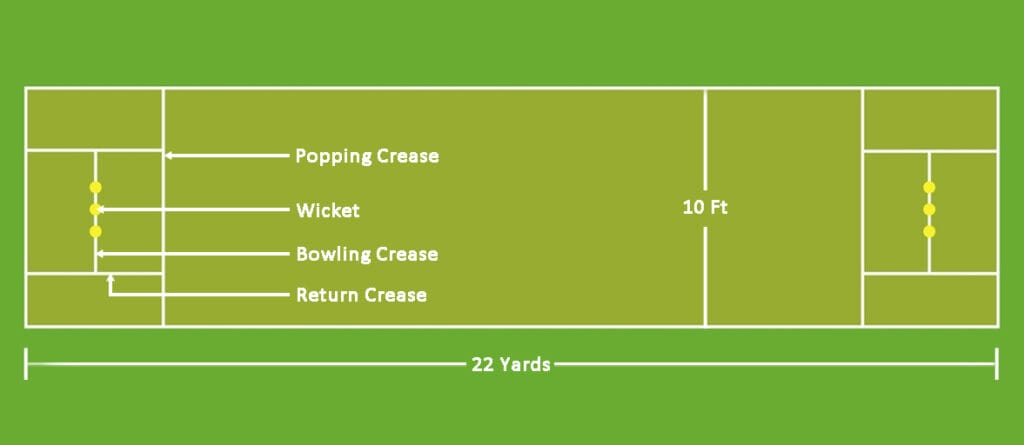Cricket is a sport steeped in tradition and complexity, enjoyed by millions worldwide. ICC is the governing body of cricket worldwide. They make and implement the rules. The rules of cricket are crucial for appreciating the game. They are also key for playing well. This is true whether you’re a casual viewer or an aspiring player.
Cricket is played between two teams, each consisting of eleven players. The game is divided into innings, with each team taking turns to bat and bowl. The batting side’s goal is to score many runs. The bowling side aims to limit scoring and dismiss the batsmen.
Teams and Players
Cricket is played between two teams, each consisting of 11 players. Players are categorized into specialist batsmen, bowlers, all-rounders, and wicket-keepers.
- Specialist Batsmen: Focus primarily on batting, aiming to score runs and protect their wicket.
- Specialist Bowlers: Focus on bowling, aiming to dismiss batsmen and restrict scoring.
- All-Rounders: Make key contributions with the bat as well as the ball, adding much-needed balance to the team.
- Wicketkeeper: He is positioned behind the stumps. He is responsible for catching balls the batsman misses and making dismissals.
- Substitutes: Teams can use substitutes for fielding but not for batting or bowling.
Dimensions of the Cricket Field
The cricket field is carefully laid out. It ensures a standard playing environment for all game formats.
- Pitch: The pitch is 22 yards (20.12 meters) long and 10 feet (3.05 meters) wide.
- Wickets: Each wicket consists of three vertical stumps and two horizontal bails on top. The wicket is 28 inches (71.1 cm) tall and 9 inches (22.9 cm) wide.
- Boundary: The distance from the center of the pitch to the boundary varies. It’s usually 65 to 90 yards (59 to 82 meters) in international cricket.
- 30-Yard Circle: A fielding restriction circle is marked 30 yards (27.43 meters) from the center of the pitch. It is used to regulate fielding positions during powerplays in limited-overs formats.

Key Rules of Cricket
The key rules of cricket ensure fair play in all formats. They provide the framework for how the game is played. These rules cover everything. They include runs, dismissals, fielding, and bowling. One must know these basics to appreciate cricket’s depth and excitement.
The Toss:
Before the match starts, a coin toss determines which team will bat or bowl first. The winning captain chooses between batting or bowling.
Scoring Runs:
In cricket, the batting team’s main goal is to score runs. This adds to their total and helps them beat the opposition. Here’s a closer look at how runs are scored in cricket:
- Runs are scored by hitting the ball and running between the wickets. Each successful run adds to the team’s total.
- If the ball hits the ground before crossing the boundary, four runs are added to the score.
- If the ball crosses the boundary without touching the ground, six runs are added to the score.
- Runs scored when the batsman misses the ball, and it passes the wicketkeeper are termed byes. These runs are added to the total of the team but not of the batsman.
- Runs scored when the ball hits the batsman’s body (excluding the hand) are termed leg byes. These runs are added to the total of the team but not of the batsman.
- Runs can also be awarded as extras due to violations by the fielding team, such as no-ball, wide, and overthrows.
Types of Dismissals:
In cricket, the fielding team aims to dismiss the batsman. This limits the opposing team’s ability to score runs. Here’s a detailed look at how a batsman can be dismissed in cricket using various methods.

- Bowled: The ball hits the stumps, dislodging the bails.
- Caught: The batsman hits the ball, and a fielder catches it before it touches the ground.
- Leg Before Wicket (LBW): The batsman is out if the ball hits their body (not the bat) and would have hit the stumps.
- Run Out: A batsman is out if the fielding side hits the stumps with the ball before the batsman reaches the crease.
- Stumped: The wicketkeeper puts down the wicket while the batsman is out of the crease and not attempting a run.
- Hit Wicket: The batsman dislodges the bails with their bat or body while playing a shot or setting off for a run.
- Handling the Ball: The batsman deliberately handles the ball with their hands without the umpire’s consent.
- Obstructing the Field: The batsman deliberately obstructs a fielder from making a play.
- Timed Out: The next batsman fails to appear on the field within three minutes of the previous wicket falling.
Overs and Bowling:
Bowling is key in cricket. It aims to limit the batting team’s runs and dismiss batsmen. The concept of “overs” is central to bowling. They dictate its rules and strategy. Here’s an overview of how overs and bowling operate according to the rules of cricket:
- An over consists of six legal deliveries by a bowler. After each over, a different bowler must be used, and the end from which the bowler bowls alternates.
- There is also a limit of maximum over a bowler can bowl in a limited overs match
- A bowler can ball a maximum of 10 overs in an ODI.
- A bowler can ball a maximum of 4 overs in a T20.
Fielding Rules:
In cricket, fielding is vital. It supports the bowlers and limits the batsmen’s runs. Fielders are positioned around the ground to catch the ball, stop runs, and help dismiss batsmen. Here’s a detailed look at the key fielding rules in cricket:
- Fielders are positioned around the field to catch the ball, prevent runs, and assist in dismissals.
- There are limits on the number of fielders allowed outside the 30-yard circle in Limited over-game.
- Fielders must not interfere with the batsmen’s running or obstruct the ball’s path.
- The wicketkeeper, who stands behind the stumps, can assist in dismissals and is the only player allowed to wear gloves and a protective pad.
Umpiring Decisions:
Umpires enforce the rules of cricket and make critical decisions, such as calling dismissals and monitoring overs. Their decisions can be reviewed using technology in modern cricket formats.
Game Formats
Cricket is played in various formats, each with its unique rules and strategies:
- Test Cricket: The longest format, played over five days with two innings per side. It allows for a deep strategic approach and demands endurance from players.
- One Day International (ODI): Each team plays a single innings of 50 overs. This format balances aggression with strategy and is known for its thrilling matches.
- Twenty20 (T20): Each team plays a single innings of 20 overs. This fast-paced format emphasizes aggressive batting and dynamic fielding, often resulting in high-scoring games.
- Emerging Formats: They introduced new formats, like The Hundred, to attract diverse audiences. The formats also provide new challenges.
Common Violations and Penalties
Adherence to the rules of cricket is essential for maintaining fairness and excitement in the game. Here are some common violations and their penalties:
- No-Ball: A delivery that is illegal due to the bowler overstepping the crease or an incorrect action. The batting side is awarded one extra run, and the delivery is replayed.
- No Ball for Height: A delivery that passes above the batsman’s waist when in their normal stance. The batting side receives one extra run, and the delivery is replayed.
- Wide Ball: A ball delivered outside the batsman’s reach, making it impossible to play a legitimate shot. The batting side receives one extra run, and the delivery is replayed.
- Dead Ball: Called when the ball becomes unplayable or if there is interference or interruption. No runs or dismissals can occur from a dead ball, and the delivery is not counted.
- Short Run: When a batsman fails to reach the crease before the ball is returned. The run is not counted.
- Overthrow: If the fielder tries to return the ball to the wicketkeeper or stumps but misses, the ball goes into the field. The batting side can take advantage by taking extra runs.
Conclusion
Understanding the rules of cricket enhances the enjoyment and appreciation of the game. Whether you’re watching a match or playing with friends. Knowing the rules helps you engage more with this lively sport. So, next time you watch or play cricket. You’ll better grasp what’s happening on the field and why certain decisions are made.







